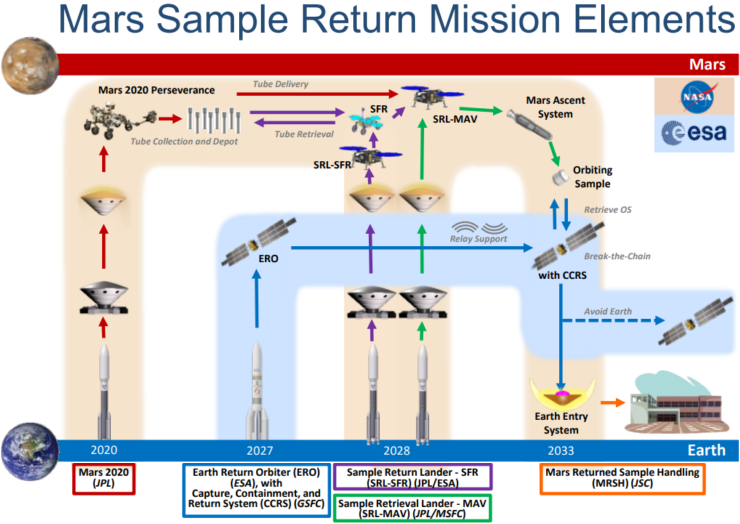Файл:Mars Sample Return mission 2020-2033.png
Mars_Sample_Return_mission_2020-2033.png (740 × 524 пкс, размер файла: 185 КБ, MIME-тип: image/png)
Этот файл из на Викискладе и может использоваться в других проектах. Информация с его страницы описания приведена ниже.
Краткое описание
| ОписаниеMars Sample Return mission 2020-2033.png |
English: NASA revealed significant changes to two of its flagship planetary science missions at today’s Space Science Week meeting at the National Academies of Sciences, Engineering and Medicine. The cost for Europa Clipper, which will gather data as it makes multiple swingbys of Jupiter’s moon Europa, has grown from $4.25 billion to $5 billion. Separately, NASA and ESA are replanning the Mars Sample Return mission. Two landers are needed instead of one to retrieve samples from the surface of Mars and boost them into orbit for their trip back to Earth. The launches will be in 2028 instead of 2026.Zurbuchen also shared news about the Mars Sample Return mission that surely will increase its cost, but he did not say how much.
NASA and ESA are partners in the multi-spacecraft mission to bring samples of Mars back to Earth for analysis. NASA’s Mars Perseverance rover is already on Mars collecting samples that it is leaving on the surface in cigar-shaped tubes. A Sample Fetch Rover will be sent to collect them and take them to a Mars Ascent Vehicle — a rocket — that will shoot them into Martian orbit where they will be transferred to an Earth Return Orbiter for the trip back to Earth. Initially the plan was for the fetch rover and ascent vehicle to be launched together in 2026, and the Earth Return Orbiter in 2027. But Zurbuchen decided to convene an Independent Review Board in 2020 to get an impartial assessment of the plan by outside experts. The Board cautioned that 2026 was “not achieveable” with 2028 a more realistic date, and that the “program’s schedule and cost are not aligned with its scope.” Consequently, NASA now has replanned the mission with two landers — one each for the fetch rover and ascent vehicle — instead of one. Both landers will launch in 2028. The Earth Return Orbiter will still launch in 2027. The samples will get back to Earth in 2033.The program is still in its early stages with the KDP-B review scheduled for June. That will mark the transition from Phase A, concept and technology development, to Phase B, preliminary design and technology completion. NASA and ESA signed a Memorandum of Understanding to work together on Mars Sample Return in October 2020. NASA built the Perseverance rover, the first mission in this campaign. ESA is building the fetch rover and Earth Return Orbiter. NASA is building the ascent vehicle, and the sample capture mechanism and Earth reentry capsule for the Earth Return Orbiter. Separate from the Mars Sample Return mission, ESA planned to launch a Mars rover, ExoMars 2022, in partnership with Russia this September. It canceled those plans after Russia invaded Ukraine and is now looking at alternatives for getting its rover to Mars. Whether that will have any impact on the Mars Sample Return planning is unknown at this point. |
|||
| Дата | 21 March 2022 | |||
| Источник | https://spacepolicyonline.com/wp-content/uploads/2022/03/TZ-MSR-archtre-Mar-21-2022-1024x582.png | |||
| Автор | NASA/Thomas Zurbuchen | |||
| Другие версии |
|
Лицензирование
| Public domainPublic domainfalsefalse |
| Этот файл находится в общественном достоянии (англ. public domain), так как он был создан NASA (Национальным управлением по аэронавтике и исследованию космического пространства). Политика авторского права NASA гласит, что «Материал NASA не защищается авторским правом, если не указано иное». (См. Template:PD-USGov, страницу политики авторского права NASA или политику использования изображений JPL.) |  | |
 |
Предупреждения:
|
Краткие подписи
Элементы, изображённые на этом файле
изображённый объект
История файла
Нажмите на дату/время, чтобы увидеть версию файла от того времени.
| Дата/время | Миниатюра | Размеры | Участник | Примечание | |
|---|---|---|---|---|---|
| текущий | 15:58, 4 сентября 2022 |  | 740 × 524 (185 КБ) | Cherurbino | Uploaded a work by NASA/Thomas Zurbuchen from https://spacepolicyonline.com/wp-content/uploads/2022/03/TZ-MSR-archtre-Mar-21-2022-1024x582.png with UploadWizard |
Использование файла
Нет страниц, использующих этот файл.
Глобальное использование файла
Данный файл используется в следующих вики:
- Использование в en.wikipedia.org
Метаданные
Файл содержит дополнительные данные, обычно добавляемые цифровыми камерами или сканерами. Если файл после создания редактировался, то некоторые параметры могут не соответствовать текущему изображению.
| Горизонтальное разрешение | 28,35 точек на сантиметр |
|---|---|
| Вертикальное разрешение | 28,35 точек на сантиметр |


